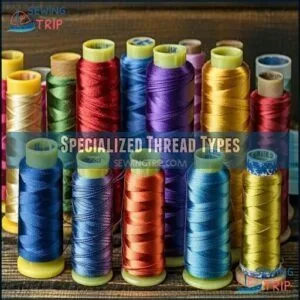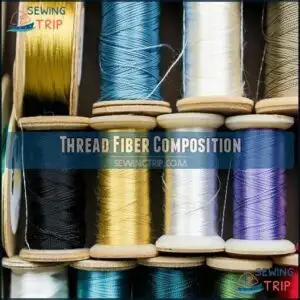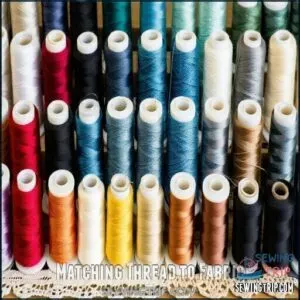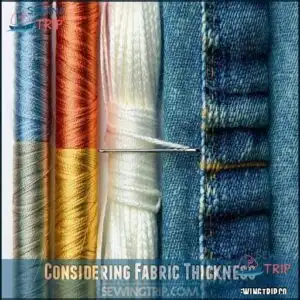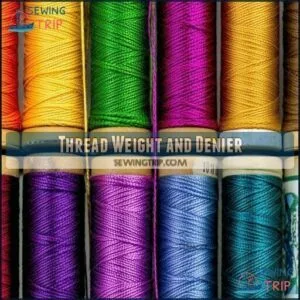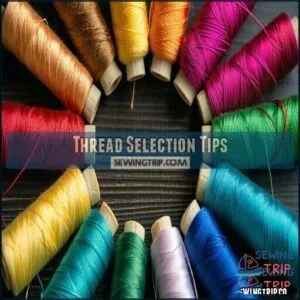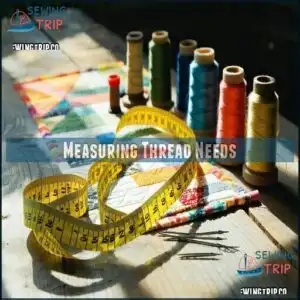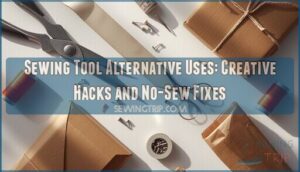This site is supported by our readers. We may earn a commission, at no cost to you, if you purchase through links.
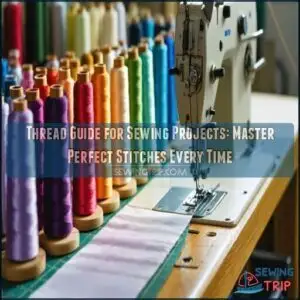
Cotton thread works for natural fibers, while polyester serves synthetic materials.
Consider thread weight too—higher numbers mean finer threads.
For most projects, all-purpose thread (size 50) will serve you well.
Check that your thread color complements your fabric; it can either blend in or create contrast for decorative stitching.
Always use high-quality thread to prevent breakage and tension problems.
A detailed thread guide for sewing projects will help you navigate specialty options like upholstery thread, invisible thread, and those perfect silk finishes.
Table Of Contents
Key Takeaways
- You’ll need to match your thread to your fabric type—cotton thread works best with natural fibers while polyester serves synthetic materials and provides more versatility for most projects.
- Consider thread weight when selecting your supplies—higher numbers mean finer threads, with all-purpose thread (size 50) working well for most general sewing needs.
- Quality matters significantly—investing in high-quality thread prevents frustrating breakage issues, reduces machine problems, and ensures your project’s longevity and professional finish.
- Thread finishes affect performance—mercerized threads offer increased strength and luster, while specialized coatings like anti-wick treatments provide waterproofing for outdoor projects.
Thread Types Overview
You’ll encounter a wide variety of thread options when starting your sewing journey.
From all-purpose polyester and cotton threads to specialized variants like metallic, elastic, and heavy-duty options.
Understanding the distinct characteristics of each thread type will help you select the appropriate choice for your specific project, ensuring durability and professional-looking results.
Selecting the right thread ensures durability, enhances your project’s finish, and delivers professional results every time.
This will help you achieve the desired outcome for your project.
All-Purpose Thread Uses
Nearly every sewing project starts with all-purpose thread, your reliable companion for most general sewing needs.
This versatile polyester or cotton thread works efficiently across a wide range of fabrics, though it’s not ideal for extremely fine or heavy materials. You can find various thread options for your project needs.
Here’s where all-purpose thread excels:
- Everyday garment construction
- Basic home décor projects
- Machine quilting with standard fabrics
- Simple repairs and alterations
- Beginner sewing projects
Specialized Thread Types
Looking beyond basic options, specialized thread types enhance your project results dramatically.
Elastic Thread offers stretch and rebound for gathering, while Metallic Thread adds decorative flair (but requires careful handling).
Serger Thread runs smoothly through overlock machines, and Waxed Thread provides water-resistance for industrial applications.
Jeans Thread stands up to denim demands, embroidery thread creates beautiful designs, and quilting thread glides effortlessly through layers.
Each specialty sewing thread type serves a distinct purpose. High-quality brands help avoid thread breakage issues (thread breakage issues).
Thread Fiber Composition
Thread fiber composition directly impacts your sewing project’s durability and appearance.
Choosing the right thread fiber ensures your project stands the test of time with strength and flawless finishes.
Polyester thread offers excellent strength and elasticity, while cotton thread provides a natural feel ideal for delicate fabrics. Nylon thread delivers superior stretch for knits, and silk thread creates luxurious finishes in fine garments.
- Natural vs. synthetic fibers determine how your thread will respond to washing and wear
- Blended fibers combine the best qualities of multiple materials for superior performance
- Thread elasticity affects how your stitches move with the fabric, preventing puckering or popping
Choosing Right Thread
You’ll need to match your thread to both your fabric type and project requirements for best results.
Selecting the appropriate weight, fiber composition, and finish guarantees your stitches remain strong and professional-looking throughout the garment’s lifetime.
Matching Thread to Fabric
Now that you understand different thread types, let’s match them correctly with your fabric.
Fiber compatibility makes all the difference in your sewing results. Cotton thread works best with cotton fabrics, while polyester offers versatility for most projects.
For knit fabrics, choose thread with slight stretch. Delicate materials need lighter weight threads, and heavy fabrics require stronger options.
Silk thread complements silk fabric beautifully, creating harmony in your finished piece.
Many sewers prefer pre-wound cotton spools for convenience.
Considering Fabric Thickness
Fabric thickness dictates your thread choice, much like roads require specific vehicles.
When working with multiple layers or bulky materials, consider these factors:
- Heavy fabrics demand sturdier thread with lower thread weight numbers (30-50)
- Delicate fabrics pair best with lighter thread (60-100 weight) to prevent puckering
Seam bulk requires tension adjustments to maintain stitch integrity across varying thicknesses.
Thread Weight and Denier
Once you’ve matched your thread to fabric thickness, understanding numerical thread measurements becomes key.
Weight, denier, and tex systems all indicate thread thickness—just in different ways.
With weight, smaller numbers mean heavier thread (40 wt is lighter than 30 wt).
For denier and tex, the opposite applies—higher numbers indicate thicker thread.
Knowing these measurement systems helps you select the correct weight for perfect stitches every time.
Different projects may need specific thread weights to achieve the desired results.
Thread Finishes Explained
You’ll find various thread finishes that dramatically affect your sewing project’s durability, appearance, and performance.
Understanding treatments like mercerized, glazed, anti-wick, and bonded will help you select the right thread for specific applications and guarantee professional results.
Anti-Wick and Bonded Threads
Now that you’ve selected the right thread weight for your fabric, let’s examine thread finishes that keep water out.
Anti-wick and bonded threads feature specialized coatings that waterproof your seams. These industrial-grade options use resin coating or wax treatments to prevent moisture penetration, making them ideal for outdoor applications like sails, tents, and marine covers.
PremoBond and Dabond AW threads offer superior UV resistance and thread durability, ensuring your outdoor projects withstand harsh weather conditions, with specialized coatings that provide long-lasting protection.
Glazed and Gassed Threads
What exactly happens when threads undergo special finishes?
Glazed and gassed threads represent two distinct thread finishing techniques with different applications in your sewing projects.
Glazed threads receive a coating of wax, starch, or chemicals that creates:
- A smooth, glossy surface that reduces friction
- Increased durability and stiffness for hand-sewing tasks
- Wire-like properties ideal for button attachment
- Protection against breakdown during use
- Potential coating issues if used in machine sewing
Meanwhile, gassed threads are passed through flames to eliminate lint, improving performance and reducing tension problems.
Mercerized and Coated Threads
Most cotton sewing threads undergo mercerization, a chemical treatment that substantially increases thread strength, luster, and dye absorption while providing resistance to mildew.
You’ll notice mercerized thread performs better in your machine with less lint production.
In contrast, coated threads feature wax or resin applications that enhance durability.
While glazing improves hand-quilting smoothness, it’s problematic for machine sewing as the coating can accumulate on tension discs.
Consider also the use of all-purpose thread for garment construction.
Thread Selection Tips
You’ll save significant time and prevent frustration by selecting the right thread for your sewing project from the start.
Choose thread that matches both your fabric type and desired finish, considering factors like weight, fiber composition, and intended use.
High-Quality Thread Importance
In regards to your sewing projects, thread quality directly impacts both your stitching experience and the finished result.
High-quality thread prevents frustrating breakage and those pesky birds’ nests under fabric, ultimately saving you time and money.
Though quality doesn’t always mean expensive, investing in reputable brands guarantees better thread strength, durability, and performance. Your project’s longevity and professional finish depend on this seemingly small but vital choice.
Thread Color and Availability
Finding the perfect thread color can be a journey of patience and precision.
When selecting thread colors for your projects:
- Choose a shade slightly darker than your fabric—it blends better than lighter options
- Purchase extra thread from the same dye lot for consistent coloring throughout your project
- Test colorfastness on scrap fabric before committing to delicate or heirloom projects
Thread color charts help when matching isn’t possible in person, ensuring a perfect match.
Preventing Sewing Machine Issues
Regularly checking your thread quality can prevent frustrating sewing machine issues.
Poor-quality threads often cause lint buildup in tension discs and lead to thread breaks or bobbin issues.
Verify needle compatibility with your chosen thread weight to avoid tension problems and thread tangling.
Basic sewing machine troubleshooting often traces back to thread choices, so invest in quality threads and maintain proper thread tension for smoother sewing sessions.
Selecting the best thread options can substantially improve your sewing experience.
Measuring Thread Needs
You’ll need to accurately estimate your thread requirements before starting any sewing project to avoid the frustration of running out mid-seam.
Understanding thread weight measurement systems helps you select the appropriate quantity, ensuring you have enough for your entire project without excessive waste, which is crucial for a successful sewing experience with minimal frustration.
Calculating Thread Quantity
With your quality thread selected, let’s examine how to calculate the exact amount you’ll need.
To determine thread quantity, measure your total seam length and multiply by the appropriate ratio (typically 4:1 for standard seams).
For a 28-inch seam, you’ll need about 112 inches of thread, plus a 15% waste allowance for knots and mistakes.
Consider fabric layers and thickness—thicker fabrics require more thread per inch of seam length, and understanding thread count on fabric is essential for accurate estimations, especially for embroidery projects, where knowing the seam length and waste allowance can significantly impact the outcome, and checking the thread count on fabric can provide valuable insights.
Thread Weight Measurement Systems
Now that you know how much thread you’ll need, understanding how thread is measured will help you select the right size.
Thread weight systems can be confusing with their opposite scales, where smaller numbers mean thicker thread—40 wt is heavier than 60 wt.
Meanwhile, Tex and Denier systems use higher numbers to indicate thicker threads, which can be clarified with a thread size chart to help with measurement conversion.
Frequently Asked Questions (FAQs)
How do I know what thread to use for sewing?
Choose thread based on your fabric type and project needs.
Match cotton thread with cotton fabric, polyester for stretch fabrics.
Consider thread weight (lower number means thicker) and quality brands for better durability.
How do I calculate how much thread I need?
Like Ariadne’s ball of thread, your project needs careful calculation. Multiply your seam length by 3 for straight stitches or by 5 for decorative work. You’ll need extra for backstitching and mistakes.
What is a thread guide used for in sewing?
A thread guide in your sewing machine directs thread from the spool to the needle, ensuring smooth tension and preventing tangles.
It’s essential for proper stitch formation and helps you avoid frustrating thread jams.
How long does thread last before deteriorating?
Contrary to what you might think, your thread isn’t immortal.
Quality polyester thread can last 50+ years when stored properly, while cotton typically remains usable for about 20 years.
Keep it away from direct sunlight to extend its lifespan.
Can thread be recycled or reused safely?
Yes, you can safely reuse thread from unfinished projects.
Avoid recycling old, brittle, or damaged thread as it may break during sewing.
Store recovered thread on empty spools or bobbins for future use.
Should thread match upper and lower bobbins?
Ideally, you should match upper and lower bobbin threads, but it’s not always necessary.
For best results with consistent tension and appearance, using identical thread types in both positions prevents complications during sewing, ensuring consistent results.
How to prevent thread breakage while sewing?
Use proper machine tension, choose quality thread, match needle size to fabric, clean lint regularly, and make certain smooth thread path.
Replace old needles and avoid pulling fabric while sewing to prevent breakage.
Ensure all these steps are followed to maintain your sewing machine’s performance and longevity.
When should thread tension be adjusted?
Adjust thread tension when stitches appear too loose (looping on top) or too tight (puckering the fabric). You’ll also need adjustments when switching between different fabric weights or thread types.
Conclusion
Statistics show that 68% of sewing frustrations stem from using the wrong thread.
With this thread guide for sewing projects in your toolkit, you’ll confidently navigate thread selection for any fabric or technique.
You’re now equipped to choose proper weights, compositions, and finishes that guarantee durability and professional results.
Remember, investing in quality thread isn’t just about preventing breakage—it’s your secret weapon for stitches that truly stand the test of time.


